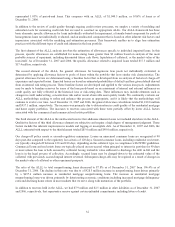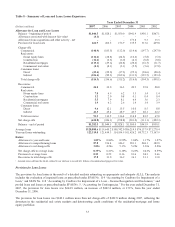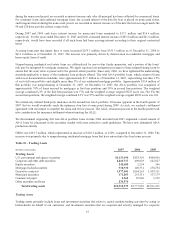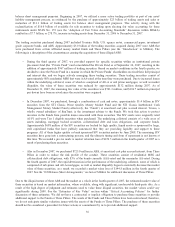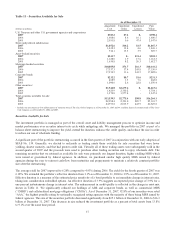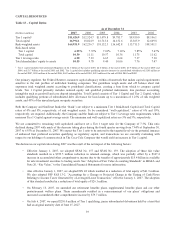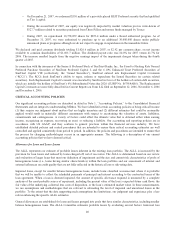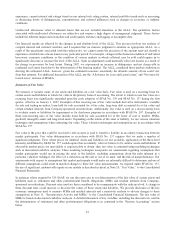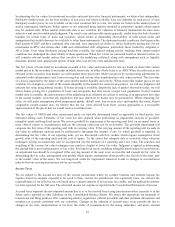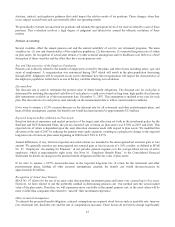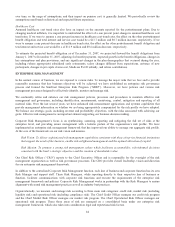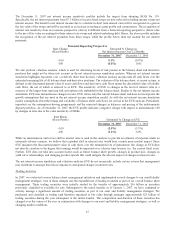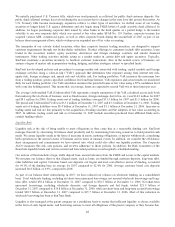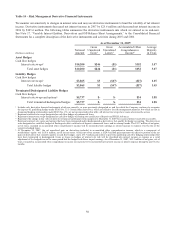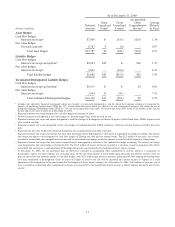SunTrust 2007 Annual Report Download - page 53
Download and view the complete annual report
Please find page 53 of the 2007 SunTrust annual report below. You can navigate through the pages in the report by either clicking on the pages listed below, or by using the keyword search tool below to find specific information within the annual report.experience, current internal risk ratings based on our internal risk rating system, internal portfolio trends such as increasing
or decreasing levels of delinquencies, concentrations, and external influences such as changes in economic or industry
conditions.
Unallocated allowances relate to inherent losses that are not included elsewhere in the ALLL. The qualitative factors
associated with unallocated allowances are subjective and require a high degree of management judgment. These factors
include the inherent imprecision in models and credit quality statistics and lagging or incomplete data.
Our financial results are affected by the changes in and absolute level of the ALLL. This process involves our analysis of
complex internal and external variables, and it requires that we exercise judgment to estimate an appropriate ALLL. As a
result of the uncertainty associated with this subjectivity, we cannot assure the precision of the amount reserved, should it
experience sizeable loan or lease losses in any particular period. For example, changes in the financial condition of individual
borrowers, economic conditions, or the condition of various markets in which collateral may be sold could require us to
significantly decrease or increase the level of the ALLL. Such an adjustment could materially affect net income as a result of
the change in provision for loan losses. During 2007, we experienced an increase in delinquency and net charge-offs in
residential real estate loans due to the deterioration of the housing market. The ALLL considered these market conditions in
deriving the estimated ALLL; however, given the continued economic uncertainty the ultimate amount of loss could vary
from that estimate. For additional discussion of the ALLL see the “Allowance for Loan and Lease Losses” and “Provision for
Loan Losses” sections of MD&A.
Estimates of Fair Value
We measure or monitor many of our assets and liabilities on a fair value basis. Fair value is used on a recurring basis for
certain assets and liabilities in which fair value is the primary basis of accounting. The extent to which we use fair value on a
recurring basis was significantly expanded upon the early adoption of SFAS No. 159 and SFAS No. 157 during the first
quarter, effective on January 1, 2007. Examples of this recurring use of fair value include derivative instruments, available
for sale and trading securities, loans held for sale accounted for at fair value, long-term debt accounted for at fair value and
certain residual interests from Company-sponsored securitizations. Additionally, fair value is used on a non-recurring basis
to evaluate assets or liabilities for impairment or for disclosure purposes in accordance with SFAS No. 107. Examples of
these non-recurring uses of fair value include loans held for sale accounted for at the lower of cost or market, MSRs,
goodwill, intangible assets and long-lived assets. Depending on the nature of the asset or liability, we use various valuation
techniques and assumptions when estimating fair value. These valuation techniques and assumptions are in accordance with
SFAS No. 157.
Fair value is the price that could be received to sell an asset or paid to transfer a liability in an orderly transaction between
market participants. Fair value determination in accordance with SFAS No. 157 requires that we make a number of
significant judgments. First, where prices for identical assets and liabilities are not available, application of the three-level
hierarchy established by SFAS No. 157 would require that we identify, what we believe to be, similar assets and liabilities. If
observable market prices are unavailable or impracticable to obtain, then fair value is estimated using modeling techniques
such as discounted cash flow analyses. These modeling techniques incorporate our assessments regarding assumptions that
market participants would use in pricing the asset or the liability, including assumptions about the risks inherent in a
particular valuation technique, the effect of a restriction on the sale or use of an asset, and the risk of nonperformance. Our
assessments with respect to assumptions that market participants would make are inherently difficult to determine and use of
different assumptions could result in material changes to these fair value measurements. As required under SFAS No. 157,
the use of significant, unobservable inputs in our models is described in detail in Note 20, “Fair Value,” to the Consolidated
Financial Statements.
In instances where required by US GAAP, we use discount rates in our determination of the fair value of certain assets and
liabilities such as retirement and other postretirement benefit obligations, MSRs and residual interests from Company-
sponsored securitizations. Discount rates used are those considered to be commensurate with the risks involved. A change in
these discount rates could increase or decrease the values of those assets and liabilities. We provide disclosure of the key
economic assumptions used to measure MSRs and residual interests and a sensitivity analysis to adverse changes to these
assumptions in Note 11, “Securitization Activity and MSRs,” to the Consolidated Financial Statements. The fair value of
MSRs is based on discounted cash flow analyses. A detailed discussion of key variables, including the discount rate, used in
the determination of retirement and other postretirement obligations is in contained in the “Pension Accounting” section
below.
41



